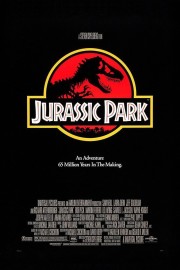Jurassic Park
Steven Spielberg’s “Jurassic Park” is among the director’s great entertainments– a rousing adventure in which Spielberg and his visual effects team make us believe that dinosaurs, once again, roam the Earth. As a film, “Jurassic Park” is most comparable to the original “King Kong,” which was also about a grand showman who thought he could control nature, and make great deals of money. True, Spielberg softens the cynical edges around John Hammond, “Jurassic Park’s” elderly billionaire, compared to Michael Crichton’s incarnation on the page, but that excitement without forethought remains. That said, there wouldn’t really be much of a movie in either case if either Hammond or Carl Denham, the director in “King Kong,” had looked before they lept.
Spielberg shows us the dangers of man and dinosaur together at the outset, as workers are trying to get a Velociraptor into a high-tech pen. When the raptor runs at the door, the shipping container it’s held in comes loose, and the raptor kills one of the door workers. Of course, we don’t know that this is a Velociraptor when the film starts, but like Spielberg did in “Jaws,” he’s a clever bugger when it comes to defining a natural menace through images and buildup that allows our expectations to grow until he’s ready to really let ’em rip on-screen. In “Jaws,” it was by necessity since the shark didn’t work; in “Jurassic Park,” it’s calculation and a master’s touch with suspense. In both cases, audiences fell for the effect hook, line, and sinker.
Of course, in “Jurassic Park,” there’s more than just raptors that can kill you. There’s also the Dilophosaurus, which sprays its prey with a debilitating toxin when it has its prey cornered. And finally, there’s the Tyrannosaurus Rex, which is, for many people, the iconic dinosaur. Now, I knew a little bit about dinosaurs when I went to watch “Park” for the first time; needless to say, it was the T-Rex I was most looking forward to seeing in action. I mean really, is there a scarier beast out there when you’re a kid? Well, as it would happen, there is one scarier. Not that Spielberg treats the T-Rex with kid gloves, but he does give this dangerous creature a moment of heroism near the end, when the real villains of the film– the Velociraptors –have the human characters cornered. Actually, it’s probably less out of a desire to see the T-Rex as heroic than simply showing that this ecosystem that Hammond created is unpredictable, and that nature thrives on chaos, and cannot be controlled, which was part of the point of Crichton’s novel in the first place.
Yeah, there are human stories and characters in “Jurassic Park” also, but who is going to this movie for thoughtful introspection and depth? Yes, great filmmakers can include some depth in a shallow popcorn entertainment (and Spielberg accomplished just that during some of the best scenes in “Jaws”), but I think with “Jurassic Park,” Spielberg was just looking to make an epic action-adventure movie in the tradition of Ray Harryhausen’s films, all the while using the latest in special effects, and on that level, he succeeded marvelously. (A great story about “Jurassic Park” and Harryhausen was told by Spielberg in the invaluable documentary, “Spielberg on Spielberg.”)
That doesn’t mean Spielberg skated by on the human characters and the human dimensions, as some critics have asserted. (Watch this film’s sequels to see gross examples of character negligence.) The best example is Dr. Alan Grant (Sam Neill), and his relationship with Hammond’s grandchildren, Lex (Ariana Richards) and Tim (Joseph Mazzello). Initially, these two look like cardboard cutouts of the “annoying kid” syndrome most blockbusters suffer from, but after Grant has to rescue the kids when the power goes out, and their tour vehicles stop in front of the T-Rex fence, we see these kids as a little more than cliches, and Grant as someone who could truly look out for his own if he and his girlfriend, Ellie Sadler (Laura Dern), were to ever have kids. The best examples of this are, coincidentally enough, both set in trees: the first when Tim is stuck in the tour car after the T-Rex attack; and the second is when Grant, Lex, and Tim are resting in another tree over by a herd of Brachiosauruses, a moment which contains not only one of Spielberg’s best scenes in the movie, but one of John Williams’s best cues of his majestic score.
It’s in sights and sounds that “Jurassic Park” made its greatest impact, both at the time of its release, as well as when one watches it over as the years go along. By Spielberg’s own admission, this was the first film in which the main characters, that determined the success and failure of the film, were done through digital special effects (and yes, I’m well aware Cameron did similar marvels first with “The Abyss” and “Terminator 2”), and the team at Industrial Light & Magic work wonders that still hold up today, whether it’s a couple of raptors hunting Lex and Tim in an industrial kitchen (one of Spielberg’s best set pieces ever); a group of humans outrunning a T-Rex in a jeep; or a herd of Gallimimus running in an open field. Complain all you want about the human characters being one-dimensional– that doesn’t make Jeff Goldblum’s sarcastic mathematician, Dr. Ian Malcolm, any less fun to watch. The reason I will continue to watch “Jurassic Park” throughout the years, regardless of its shortcomings as art, is because it continues, time and time again, to leave me with a sense of awe and fun in what Steven Spielberg and Michael Crichton, and John Williams and Dennis Muren, and the rest of ILM’s magicians, accomplished in this epic adventure.










